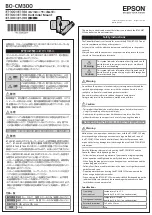
10CH Essential Instructions R1.docx
2022/10/24
8
Ensure that the active portions of the two main antennas (the silver section about 31mm long) are well
separated from each other and from conductive items such as wiring, battery and carbon fibre. They should be
approximately at right angles to each other. Take care not to kink the cables.
The receiver must be firmly mounted to the structure of the aircraft with the double-sided mounting tape
supplied or other vibration-absorbing material. It must not be able to wobble or come loose in flight. Hook-and-
loop material can be used, but only if care is taken to ensure that this requirement is met.
Given the dual diversity antenna setup of the Lemon receiver, a satellite receiver is not normally required, but
can be used if desired for extra signal reliability. It should be well separated from the main receiver.
Make sure you can access the three gain pots on the receiver, as you will need to adjust them after test flights,
perhaps repeatedly.
5. Connect servos and speed control (ESC), set switches and wing type
Plug the servos and ESC into the appropriate slots on the receiver. For information on options for powering the
receiver, see Step 1 (page 3). Normally, the Stabilization ON/OFF channel slot (channel 5 or 7) will be empty, as it
is used internally by the receiver, as will the Master Gain slot (channel 8).
On the transmitter, set wing type (in the Aircraft Type menu) as shown below; in all cases, the tail type is
Normal, even for a V-Tail model.
Important safety warning: Leave the motor unconnected or remove the propeller when programming or
testing an electric powered model. Electric models can bite!
Configuration for Various Model Types (Stabilization Options)
Model Type
Channel Assignments
Wing Type
Stabilizer LEDs
1
2
3
4
5
6
7
8
R1
R2
R3
Conventional
(one Ail channel)
Thr
Ail
Ele
Rud
*
On/Off
Master
Gain
Normal
✓ ✓
X
Conventional
(two Ail channels)
Thr
RAil
Ele
Rud
*
LAil
On/Off
Master
Gain
Dual Ail/
Flaperon
✓
✓
✓
Delta Wing
(Elevons)
Thr
RElev
LElev
Rud
*
On/Off
Master
Gain
Normal
✓
X
X
V-Tail
(one Ail channel)
Thr
Ail
RTail
LTail
*
On/Off
Master
Gain
Normal
X
✓
X
V-Tail
(two Ail channels)
Thr
RAil
RTail
LTail
*
LAil
On/Off
Master
Gain
Dual Ail/
Flaperon
X
✓
✓
* Used for Stabilization On/Off on 6 channel transmitters; otherwise used as a normal servo output.
6. Verify control directions, adjust centring and servo throws
1.
Power ON. Use the Stabilizer ON/OFF switch to turn stabilization OFF (green Status light OFF). Be sure
you know which way is OFF in case you need to use it in a hurry!
2.
Adjust transmitter reversing so that all servos work in the correct direction in response to the sticks. Note
that where elevon, V-tail or flaperon mixing is involved it may be necessary to interchange the two servo
connectors and/or reverse controls to get the correct action.
3.
With trims in neutral, adjust servo arms and linkages to align your control surfaces. Use only a minimum
of subtrim on the transmitter for fine tuning. Servo arms should be at right angles to push rods to ensure
equal movement in both directions.
























